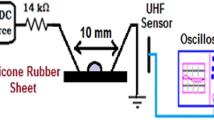Abstract
This paper presents experimental results of the surface charges and charge decay measurement on the surface of polymeric insulator. In this research, the effect of surface charges on electric field and potential distribution has been investigated. Therefore, using measured electric charge and charge decay, the electric field and surface potential on insulator are studied by computer simulations. The accumulation of electric charge under DC electric field makes a significant difference compared to AC electric field, and this increases the rate of electrical failure and corrosion in HVDC insulators. So, a thorough understanding of the surface charge effect on insulation performance is necessary under various stresses. The experimental results revealed that the amount of charges increases linearly with the rising corona voltage and the charging time for both polarities. It was also observed that the amount of surface charges deposited by positive corona charging is less than negative corona charging. The simulation results illustrate that surface charges are important in potential and electric field variations.













Similar content being viewed by others
References
Abbasi A, Shayegani A, Niayesh K (2014) Contribution of design parameters of SiR insulators to their dc pollution flashover performance. IEEE Trans Power Deliv 29:1814–1821. https://doi.org/10.1109/TPWRD.2013.2285223
Othman NA, Piah MAM, Adzis Z, Ahmad H, Ahmad NA, Kamarden H, Suleiman AA (2014) Characterization of charge distribution on the high voltage glass insulator string. J Electrostat 72:315–321. https://doi.org/10.1016/j.elstat.2014.05.003
Zhijin Z, Xinliang J, Yafeng C, Caixin S, Jianlin H (2010) Influence of low atmospheric pressure on ac pollution flashover performance of various types of insulators. IEEE Trans Dielectr Electr Insul 17:425–433. https://doi.org/10.1109/TDEI.2010.5448097
Se-Ondoua MM, Zebouchi N, Hoang G (1997) The study of space charge effect on dielectric dc breakdown of synthetic insulators with the pressure wave propagation method. J Electrostat 40:355–361. https://doi.org/10.1016/S0304-3886(97)00070-3
Kumara S, Alam S, Hoque IR, Serdyuk YV, Gubanski SM (2012) Surface charges on cylindrical polymeric insulators. IEEE Trans Dielectr Electr Insul 19:1076–1083. https://doi.org/10.1109/TDEI.2012.6215115
Srivastava KD, Morcos MM (2001) A review of some critical aspects of insulation design of GIS/GIL systems. In: Transmission and distribution conference and exposition. https://doi.org/10.1109/tdc.2001.971338
Ahmad H, Salam MA, Ying LY, Bashir N (2008) Harmonic components of leakage current as a diagnostic tool to study the aging of insulators. J Electrostat 66:156–164. https://doi.org/10.1016/j.elstat.2007.11.004
Ehnberg SGJ, Blennow HJM (2003) Effects of surface charge accumulation on impulse flashover voltage on silicone rubber surface. In: 13th Int’l. Sympos. High Volt. Eng. (ISH), p 242. http://goo.gl/pxeuo8
Blennow J, Sörqvist T (2005) Effect of surface flashover voltage of polymer materials. In: 9th Nordic Insul. Symp. (NORD-IS), pp 262–265
Tenbohlen S, Schröder G (2000) The influence of surface charge on lightning impulse breakdown of spacers in SF6. IEEE Trans Dielectr Electr Insul 7:241–246. https://doi.org/10.1109/94.841816
Wang F, Qiu Y, Pfeiffer W, Kuffel E (2004) Insulator surface charge accumulation under impulse voltage. IEEE Trans Dielectr Electr Insul 11:847–854. https://doi.org/10.1109/TDEI.2004.1349790
Darveniza M, Saha TK, Leijon MA, Wright S (2001) Effects of deposited charge on impulse test techniques for polymeric insulators. In: CIGRE. http://goo.gl/42wfZQ
Hammam MSAA, Ochiai S, Burns C (1991) Effect of 50% flashover voltage due to accumulated charge on the surface of polymeric insulators. In: Proceedings of the 3rd international conference, pp 981–984. https://doi.org/10.1109/icpadm.1991.172237
Muniraj C, Chandrasekar S (2011) Investigation of the arc activity on high-voltage polymeric insulators. Int J Power Energy Syst 2:01–08. https://doi.org/10.2316/Journal.203.2011.2.203-4802
Kumara S, Serdyuk YV, Gubanski SM (2010) Simulation of surface charge effect on impulse flashover characteristics of outdoor polymeric insulators. IEEE Trans Dielectr Electr Insul 17:1754–1763. https://doi.org/10.1109/TDEI.2010.5658226
Liu Z, Jiang P, Qui Y, Feng Y (2000) Pre-charging effects on low probability DC flashover along insulating spacer surface. In: Proceedings of the 6th international conference on properties and applications of dielectric materials, pp 603–606. https://doi.org/10.1109/icpadm.2000.876085
Jun X, Chalmers ID (1997) The influence of surface charge upon flashover of particle-contaminated insulators in SF6 under impulse-voltage conditions. J Phys D Appl Phys 30:1055–1063. https://doi.org/10.1088/0022-3727/30/7/001
Kumara S (2012) Electrical charges on polymeric insulator surfaces and their impact on flashover performance. Dissertation Chalmers University of Technology
Molinié P (2012) A review of mechanisms and models accounting for surface potential decay. IEEE Trans Plasma Sci 40:167–176. https://doi.org/10.1109/TPS.2011.2171372
Othmana NA, Piahb MAM, Adzisb Z (2017) Charge distribution measurement of solid insulator materials: a review and new approach. Renew Sustain Energy Rev 70:413–426. https://doi.org/10.1016/j.rser.2016.11.237
Qi B, Gao C, Li C, Zhao L, Sun X (2015) Effect of surface charge accumulation on flashover voltage of GIS insulator in SF6 under DC and AC voltages. Ann Rep Conf Electr Insul Dielectr Phenom. https://doi.org/10.1109/CEIDP.2015.7352094
Alam S, Serdyuk YV, Gubanski SM (2015) Potential decay on silicone rubber surfaces affected by bulk and surface conductivities. IEEE Trans Dielectr Electr Insul 22:970–978. https://doi.org/10.1109/TDEI.2015.7076798
Arora R, Mosch W (2011) High voltage insulation engineering. Wiley, Hoboken
Li Y, Zhu L (2015) Main insulation electric field calculation and analysis software for power transformer. IEEE Int Magn Conf (INTERMAG) 50:52–56. https://doi.org/10.1109/INTMAG.2015.7157210
Lowke JJ (1992) Theory of electrical breakdown in air- the role of metastable. J Phys D Appl Phys 25:202–210. https://doi.org/10.1088/0022-3727/25/2/012
Author information
Authors and Affiliations
Corresponding author
Additional information
Publisher’s Note
Springer Nature remains neutral with regard to jurisdictional claims in published maps and institutional affiliations.
Rights and permissions
About this article
Cite this article
Mahmoodi, J., Mirzaie, M. & Akmal, A.A.S. Surface charges on silicon rubber (SiR) insulator and their effect on potential and electric field distribution. Electr Eng 100, 2695–2705 (2018). https://doi.org/10.1007/s00202-018-0740-6
Received:
Accepted:
Published:
Issue Date:
DOI: https://doi.org/10.1007/s00202-018-0740-6




